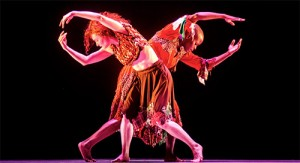By SUSAN REITER
Matthew Rushing has been one of the Alvin Ailey American Dance Theater's most indispensable and inspired dancers for over 20 years. These days, he wears two hats with the company. In addition to his responsibilities as Rehearsal Director, he continues to perform regularly as a guest artist. He delivers riveting interpretations of roles in classic Ailey works, but he also shows his versatility in recent choreography by Ronald K. Brown and Aszure Barton.
In case he wasn't keeping busy enough, this season Rushing is wearing a third hat: he choreographed the major premiere of Ailey's
current City Center season, ODETTA. The ambitious 40-minute work---set to and inspired by the songs of the multifaceted singer and civil rights activist---will receive five more performances during the season, which continues through January 4th.
Rushing admits that when Robert Battle, Ailey's artistic director, suggested he create a dance using Odetta's music, he had only the vaguest awareness of her extensive career and its impact and influence. "I felt like I should have known more, by the way he asked," Rushing says. "In the back of my head, it sounded familiar. Once I got home, I did some research, and of course I knew some of her songs. And there are certain pieces of music that are timeless. I'm pretty sure I had heard Odetta sing 'Motherless Child.'"
Odetta Holmes (1930-2008) had a musical career that endured for over 50 years. Her earliest performances were in musical theatre; at 18, she appeared in the national tour of
Finian's Rainbow. But it was as a powerful, pioneering interpreter of folk songs, spirituals, and blues that she achieved fame and was cited as an influence on Bob Dylan, Harry Belafonte, and others.
Odetta was called the voice of the Civil Rights Movement and appeared at the 1963 March on Washington, singing "Oh, Freedom." On David Letterman's first show after the 9/11 attacks, she soothed a wounded nation by singing "This Little Light of Mine," the spiritual that always opened her concerts. She made numerous recordings (earning her final Grammy nomination in 2007) and continued to give concerts until shortly before her death.
After Battle made his proposal, Rushing says, "I spent a lot of time listening to her music and doing research: interview footage, YouTube clips. As I listened to her music, I was touched by the nobility she had, the richness and power in her voice. I was impressed by how she incorporated the history of the prison songs and the work songs and how much work she had to do in terms of researching folk music. Then to hear her speak about what inspired her and also what she went through, and how she used her music for personal healing---that really spoke to me."
Rushing continues, "The hardest task was to narrow down the songs I was going to use. She had such a huge repertory. I always work from music, so I structured the piece musically before I went into the studio. I wanted to introduce Odetta to Ailey audiences that are not familiar with her work. One of my goals was to show her versatility, so I chose music from each genre---folk, spirituals, prison and work songs, blues. Also I chose to incorporate excerpts from interviews, small segments to provide a through-line that knits the sections together."
Rushing shaped the central role for Hope Boykin, an especially dynamic veteran Ailey member. The two are close friends as well as colleagues; Rushing's first choreographic venture for the company was a 2005 collaboration with Boykin and another Ailey dancer. Describing her work with Rushing, Boykin says, "Sometimes your closest friends are just like family. He's always been my brother."
Rehearsals for
ODETTA began just as Boykin was returning from a shoulder surgery that kept her offstage over the summer. Rushing soothed her doubts about doing justice to the piece when he told her, "I made this role for you." His confidence in her, Boykin says, "makes me proud and scared at the same time. Excited and anxious. The Odetta character is embodied in every dancer in the piece, but it speaks through me; it goes from me, as Odetta, into the dancer portraying that particular song."
ODETTA grew to incorporate scenic design by Travis George---six bench-like pieces that are ingeniously rearranged to various dramatic and evocative purposes---as well as projections by Stephen Alcom. "The benches create an environment, representing one thing and then morphing into something else," Boykin says.
Rushing describes the year-long process of shaping this dance as "overwhelming. It's taught me about myself, about my confidence in choreography, about collaboration. I didn't know about bringing different artists together, and what that takes in terms of allowing them to have their freedom and not dictate. I just learned so much putting this piece together, and I'm so grateful for the experience."
---
Susan Reiter is a journalist based in New York City
Photo by Steve Wilson
